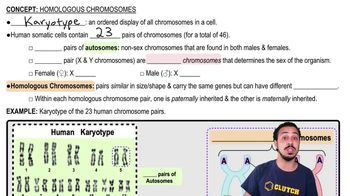Table of contents
- 1. Introduction to Biology2h 42m
- 2. Chemistry3h 40m
- 3. Water1h 26m
- 4. Biomolecules2h 23m
- 5. Cell Components2h 26m
- 6. The Membrane2h 31m
- 7. Energy and Metabolism2h 0m
- 8. Respiration2h 40m
- 9. Photosynthesis2h 49m
- 10. Cell Signaling59m
- 11. Cell Division2h 47m
- 12. Meiosis2h 0m
- 13. Mendelian Genetics4h 44m
- Introduction to Mendel's Experiments7m
- Genotype vs. Phenotype17m
- Punnett Squares13m
- Mendel's Experiments26m
- Mendel's Laws18m
- Monohybrid Crosses19m
- Test Crosses14m
- Dihybrid Crosses20m
- Punnett Square Probability26m
- Incomplete Dominance vs. Codominance20m
- Epistasis7m
- Non-Mendelian Genetics12m
- Pedigrees6m
- Autosomal Inheritance21m
- Sex-Linked Inheritance43m
- X-Inactivation9m
- 14. DNA Synthesis2h 27m
- 15. Gene Expression3h 20m
- 16. Regulation of Expression3h 31m
- Introduction to Regulation of Gene Expression13m
- Prokaryotic Gene Regulation via Operons27m
- The Lac Operon21m
- Glucose's Impact on Lac Operon25m
- The Trp Operon20m
- Review of the Lac Operon & Trp Operon11m
- Introduction to Eukaryotic Gene Regulation9m
- Eukaryotic Chromatin Modifications16m
- Eukaryotic Transcriptional Control22m
- Eukaryotic Post-Transcriptional Regulation28m
- Eukaryotic Post-Translational Regulation13m
- 17. Viruses37m
- 18. Biotechnology2h 58m
- 19. Genomics17m
- 20. Development1h 5m
- 21. Evolution3h 1m
- 22. Evolution of Populations3h 52m
- 23. Speciation1h 37m
- 24. History of Life on Earth2h 6m
- 25. Phylogeny2h 31m
- 26. Prokaryotes4h 59m
- 27. Protists1h 12m
- 28. Plants1h 22m
- 29. Fungi36m
- 30. Overview of Animals34m
- 31. Invertebrates1h 2m
- 32. Vertebrates50m
- 33. Plant Anatomy1h 3m
- 34. Vascular Plant Transport1h 2m
- 35. Soil37m
- 36. Plant Reproduction47m
- 37. Plant Sensation and Response1h 9m
- 38. Animal Form and Function1h 19m
- 39. Digestive System1h 10m
- 40. Circulatory System1h 57m
- 41. Immune System1h 12m
- 42. Osmoregulation and Excretion50m
- 43. Endocrine System1h 4m
- 44. Animal Reproduction1h 2m
- 45. Nervous System1h 55m
- 46. Sensory Systems46m
- 47. Muscle Systems23m
- 48. Ecology3h 11m
- Introduction to Ecology20m
- Biogeography14m
- Earth's Climate Patterns50m
- Introduction to Terrestrial Biomes10m
- Terrestrial Biomes: Near Equator13m
- Terrestrial Biomes: Temperate Regions10m
- Terrestrial Biomes: Northern Regions15m
- Introduction to Aquatic Biomes27m
- Freshwater Aquatic Biomes14m
- Marine Aquatic Biomes13m
- 49. Animal Behavior28m
- 50. Population Ecology3h 41m
- Introduction to Population Ecology28m
- Population Sampling Methods23m
- Life History12m
- Population Demography17m
- Factors Limiting Population Growth14m
- Introduction to Population Growth Models22m
- Linear Population Growth6m
- Exponential Population Growth29m
- Logistic Population Growth32m
- r/K Selection10m
- The Human Population22m
- 51. Community Ecology2h 46m
- Introduction to Community Ecology2m
- Introduction to Community Interactions9m
- Community Interactions: Competition (-/-)38m
- Community Interactions: Exploitation (+/-)23m
- Community Interactions: Mutualism (+/+) & Commensalism (+/0)9m
- Community Structure35m
- Community Dynamics26m
- Geographic Impact on Communities21m
- 52. Ecosystems2h 36m
- 53. Conservation Biology24m
29. Fungi
Fungi
Problem 2`
Textbook Question
After S phase, what makes up a single chromosome?
a. Two daughter chromosomes
b. A double-stranded DNA molecule
c. Two single-stranded DNA molecules
d. Two sister chromatids
 Verified step by step guidance
Verified step by step guidance1
Understand the context of the S phase in the cell cycle. The S phase, or synthesis phase, is the part of the cell cycle in which DNA replication occurs, resulting in the duplication of the cell's genetic material.
Recognize that after the S phase, each chromosome consists of two identical copies of DNA. These copies are known as sister chromatids.
Recall that a single chromosome before the S phase is made up of one double-stranded DNA molecule. After the S phase, this molecule is replicated, forming two identical double-stranded DNA molecules.
Identify that these two identical double-stranded DNA molecules are held together at a region called the centromere, forming what is known as sister chromatids.
Conclude that after the S phase, a single chromosome is composed of two sister chromatids, which are identical copies of the original chromosome.
 Verified video answer for a similar problem:
Verified video answer for a similar problem:This video solution was recommended by our tutors as helpful for the problem above
Video duration:
2mPlay a video:
Was this helpful?
Key Concepts
Here are the essential concepts you must grasp in order to answer the question correctly.
S Phase of the Cell Cycle
The S phase, or synthesis phase, is a part of the cell cycle where DNA replication occurs. During this phase, each chromosome is duplicated, resulting in two identical copies called sister chromatids. These chromatids are crucial for ensuring that each daughter cell receives an exact copy of the genetic material during cell division.
Recommended video:
Guided course

Phases of The Krebs Cycle
Chromosome Structure
A chromosome is a long DNA molecule with part or all of the genetic material of an organism. After the S phase, each chromosome consists of two sister chromatids, which are identical copies of the original chromosome. These chromatids are joined together at a region called the centromere, forming the characteristic X-shape seen during cell division.
Recommended video:
Guided course

Homologous Chromosomes
Sister Chromatids
Sister chromatids are the two identical halves of a duplicated chromosome, formed during the S phase of the cell cycle. They are connected by a centromere and are eventually separated during mitosis or meiosis to ensure that each daughter cell receives an identical set of chromosomes. This duplication and separation are essential for genetic consistency across cell generations.
Recommended video:
Guided course

Eukaryotic Chromatin Modifications
Related Videos
Related Practice












